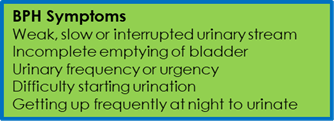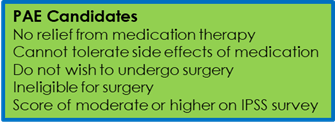You’re not alone, 70% of males between the ages 61 and 70 suffer from enlarged prostates and that percentage increases as you get older. The good news is that there is a new, minimally invasive treatment to address this condition that interferes with everyday living.
What is BPH?
Benign prostatic hyperplasia (BPH) occurs when the prostate gland increases in size. When the prostate gets larger, it presses against the urethra making it difficult for men to empty their bladder completely and can cause urinary tract or kidney problems.
What are the symptoms?
Symptoms include weak, slow or interrupted urinary stream, frequency or urgency, difficulty starting or straining to urinate, and getting up frequently at night to go to the bathroom.
These symptoms should not be ignored or written off as just part of getting older. While in many cases it’s BPH, the same symptoms can be an indication of more serious conditions, including prostate cancer, which is why it’s important to be evaluated by your physician.
How is it treated?
Historically, first line therapy starts with medication which can be very effective in reducing the symptoms but there are potential side effects like sexual dysfunction, fatigue and male breasts. Surgery is also an option, but requires a hospital stay and have a difficult recovery period.
What’s newest advancement in treatment?
If you can’t tolerate the side effects or the medication isn’t adequately controlling your symptoms, or you don’t want surgery you may be a candidate for a new, minimally invasive procedure called prostate artery embolism (PAE).
PAE is one of the most exciting breakthroughs for treating enlarged prostates. While this is a new procedure, embolization is not a new technique. It has been used for years to treat other conditions in the body. Embolization reduces the blood flow in a targeted area, which causes the target, in this case the prostate, to shrink.
There is less risk, reduced pain, no hospital stay and a shorter recovery time than with traditional procedures. In many cases, patients begin to feel relief within a few weeks. PAE can reduce the prostate up to 40% which relieves pressure on the urethra and improves symptoms.
 Are you a candidate for PAE?
Are you a candidate for PAE?
This brief survey will help determine you are a candidate for PAE. A score in the moderate or severe range means this procedure could be right for you.
